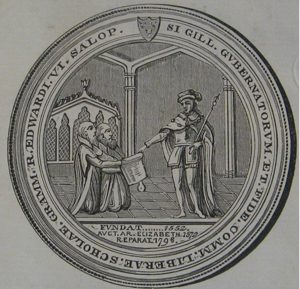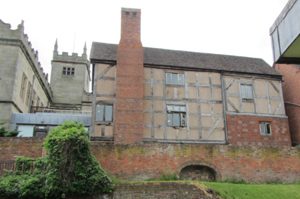
Shrewsbury School is now situated in Kingsland, where several roads are named after famous former headmasters. The road directly in front of the main entrance to the school is called Ashton Road, in remembrance of Thomas Ashton (c1500-78), who was very important in laying the foundations for the success of the school.
Shrewsbury School was founded in 1552 through the granting of a royal charter by King Edward VI (reigned 1547-53). It was originally endowed through the use of revenues obtained from the dissolution of the Colleges of St Mary and St Chad. [footnote 1] These revenues of about £20 a year were used to pay a headmaster and an assistant master, who were appointed by the Bailiffs and Burgesses of the town, with advice from the Bishop of Coventry and Lichfield. Little is known of the school in its first few years. It may well have struggled to establish itself during the reign of Queen Mary (1553-58), whose Roman Catholic government would have been less than enthusiastic about a school established as part of the Protestant reformation.
In 1561, shortly after the accession of Elizabeth I, Thomas Ashton, described as ‘a good and zealous man towards the preferment of learning’, was appointed headmaster of the school. [footnote 2] Between 1521 and 1541 Ashton had been a fellow of St John’s College, Cambridge. This college was one of the key centres of the Protestant reformation (where Ashton may have taught the tutors of Edward VI and Elizabeth I), so Ashton’s appointment was in part to spread the teachings of the Reformation to the hitherto Catholic town. [footnotes 3 & 4]] So Ashton, described by his contemporary the poet Thomas Churchyard as a ‘good and godly preacher’, had a significant influence on the religious history of the town, as well as overseeing the transformation of Shrewsbury School. During his time the school had over 290 scholars, and was later described by William Camden in his famous book Britannia as, ‘the best filled in all England, being indebted for [its] flourishing state to the provision made by the excellent and worthy Thomas Ashton. Besides the children of the gentry of this county and North Wales, many of the first people of the kingdom sent their sons there.’ [footnote 5]

But perhaps Ashton is best remembered for his Whitsuntide plays, performed in the Quarry, in a semi-circular amphitheatre where the swimming pool now is, which had been used for mediaeval miracle dramas. [footnote 6] Ashton’s plays also had religious themes, the reformers believing that drama as well as preaching was an appropriate means of spreading the truths of the gospel. Ashton’s plays were hugely popular, with audiences coming from far afield. It is even recorded that in 1565 ‘Queen Elizabeth made progress as far as Coventry intending for Salop to see Mr Ashton’s play, but it was ended’. [footnote 7] Churchyard described one of the plays as being watched by 10,000 men; while this is probably poetic licence, it is likely that the audience did reach into the thousands.

Ashton retired as headmaster of Shrewsbury School in 1571, becoming tutor to the son of the Earl of Essex, as well as travelling to the north of England and to Ireland on court business. He was also successful in increasing the endowments to the School, for which he drew up a new set of ordinances or rules for its governance, which were published just before he died in 1578, and lasted until 1798. Andrew Downes, Professor of Greek at Cambridge, and one of the translators who produced the Authorized Version of the Bible, had been one of Ashton’s former pupils at Shrewsbury School. He wrote, ‘After God and my parents he is the person to whom I am most indebted for all the literature I possess… Whatever I have of humanity, or of any good in me, proceeds from him, nor do I feel so grateful to the Almighty for anything else as for this, that, by his Providence, I enjoyed the advantage of a preceptor supreme, indeed an unparalleled felicity, that my father put me, when a boy, under the care of this most excellent person.’ [footnote 8]
Footnotes
[1] J Basil Oldham, A History of Shrewsbury School, Basil Blackwell, 1952, p.1ff
[2] CW Radclyffe, Memorials of Shrewsbury School, 1843, SA 5447/2
[3] Robin Case, Shrewsbury School, 1552-2002, private publication
[4] Bill Champion, “In depth” Thomas Ashton (died 1578), Headmaster of Shrewsbury School, http://www.discovershropshire.org.uk/html/search/verb/GetRecord/theme:20061004111708, accessed 12.6.2013
[5] Radclyffe, op. cit
[6] Champion, op. cit
[7] Radclyffe, op. cit
[8] Quoted in Champion, op. cit
